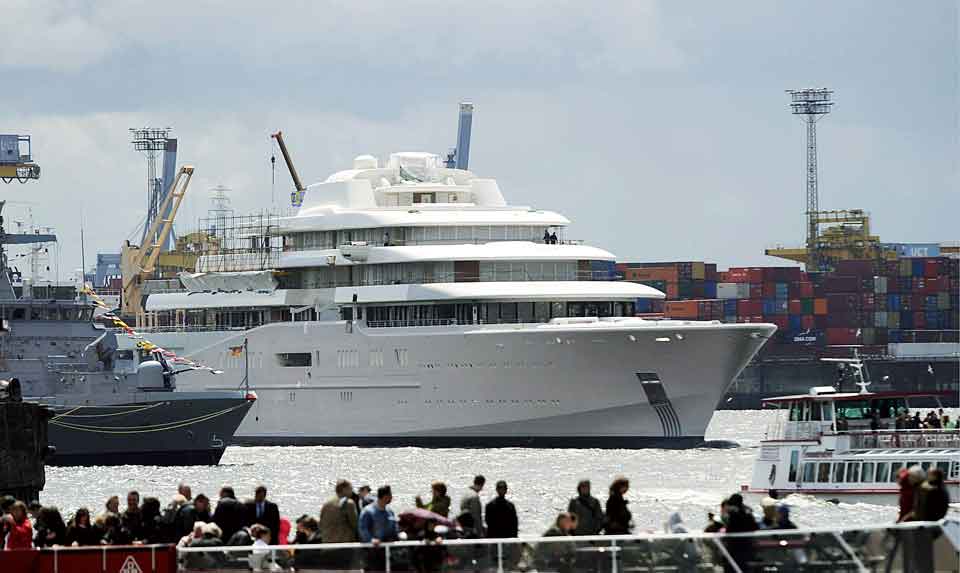Greeks third in super-yacht ownership

Greek shipowners represent the world’s biggest merchant marine fleet, but also the third largest fleet of super-yachts (40 meters and over). Greece’s seas are also the fourth most popular destination for these luxury vessels, with more than 100 super-yachts with an average length of 50 meters sailing or at anchor within two miles of the country’s shores every week of the summer months.
The findings from two recent reports by Knight Frank and Bloomberg have come as something of a surprise, even to experts in the field of luxury yachting, and show the sector growing at rapid pace in recent years, alongside tourism. This also boosts docking and repair services – as dozens of these vessels will also be spending the winter in Greece – along with the super-yacht construction sector in this country.
Lists of the world’s biggest yachts already include several built in Greece, such as the Atlantis I and Atlantis II, constructed in the early 1970s at the Skaramangas Shipyard when it was owned by Stavros Niarchos, but also the 85-meter O’Ptasia, which was built in Perama earlier this year for Greek-owned Golden Yachts.
At the same time, an entire industry of builders, suppliers, crews, brokers and managers has taken root, promising high-quality services to some of the most demanding individuals in the world, while supporting the Greek economy with a high value-added activity.
Knight Frank, one of the world’s biggest private wealth investment managers, has dedicated a part of its Wealth Report 2018 to super-yacht ownership by nationality and size. Setting the category threshold at 40 meters and above and using data from SuperYacht iQ, the report notes there are currently 4,795 leisure craft that can be described as super-yachts in the world right now. When it comes to such vessels, Greece, with 107, ranks behind Russia (168) and the US (407) in terms of absolute ownership numbers. The average Greek-owned super-yacht is 50 meters in length, Russia’s is 59 meters and the US’s 52.
Fourth place is occupied by the UK with 96 super-yachts and Saudi Arabia with 54, while the average length in the latter’s fleet is 68 meters.
Many of these super-yachts, particularly those owned by Greeks and Saudis, sail in Greek waters, which data show are the fourth busiest in terms of super-yacht traffic, behind the US, French and Italian seas. This interesting fact was reported by Bloomberg, which used the AIS ship tracking system, which most super-yachts are equipped with, and found that over a random period during the summer season there were at least 100 super-yachts of an average length of 51.7 meters at a distance of two miles from the country’s coast, compared with 200 in Italy, 147 in France and 143 in the United States. Spain comes a close fifth, with Croatia and Monaco lagging in sixth and seventh place.
It is worth noting that the presence of these luxury vessels also helps boost the popularity of smaller yachts – as is more than evident in Greece’s seas in the summer – but also the development of the country’s marinas and investor interest in them, foremost among which is Alimos Marina on Athens’s southern coast, which is set for privatization.
Over in the Piraeus suburb of Perama, workers at the Golden Yachts shipyard are building the biggest mega-yacht ever to have been constructed there. Started just a few months ago, it is a 95-meter behemoth and the company’s most ambitious project to date, known in-house as the GY95.
Golden Yachts, which is entirely Greek-owned, has already built or completely converted 14 yachts. Among these, the O’Ptasia was launched in April and completed a series of successful tests runs in the early summer. At 85 meters in length, with a maximum width of 13.8 meters and a cruising speed of 16 knots thanks to its twin 3,386hp Caterpillar 3516C engines, it is the biggest ship in the Golden Yachts fleet – at least until the GY95 is rolled out. The company, meanwhile, is also making plans to start building 100-meter-plus mega-yachts.
Golden Yachts opened in 1996 as a consultancy firm and entered construction in 1998, with the O’Rea. It started by specializing in the construction of leisure boats of 28 to 85 meters, but has now put its focus on cutting-edge, super-luxurious yachts of 60 to 110 meters. It owns many of the vessels it has built, as the aim from the outset was chartering. The firm is also active in manning and managing mega-yachts through a separate company.
Power boats also a growing market
Not a lot of Greek businesses can claim that their products are coveted around the world from Sydney to Miami and from the Maldives to Helsinki, but Technohull can. The designer and builder of cutting-edge rigid inflatable boats (RIBs) is based in the coastal Athens suburb of Alimos and has production facilities at the eastern Attica port of Lavrio.
The export-oriented company is active in the high-end part of the international market for luxury power boats, selling its products at surprisingly competitive prices – as much as 40 percent below the competition. How does it do this?
“With a lot of hard work but also with restraint in regards to our profit margin,” says Gerassimos Petratos, chairman and CEO of Technohull.
In 2005, the company was able to put together two or three boats a year. Last year it delivered 50 vessels and this year it is aiming for 70. At the same time, sales have soared from a few hundred thousand euros in the second half of the 2000s to just shy of 10 million euros last year. And from a staff of three in 2005, Technohull now employees 50 people part-time and works with 20 associates and contractors.
Around 70 percent of the company's clients are located abroad, with Technohull exporting all over Northern Europe, the Mediterranean, parts of the Middle East, Australia and the US, among others.
“The amounts we invest in research and development are among the highest in the world in this field, comparative to our size,” says Petratos.
Now, the Greek company has set its sights on being able to deliver 100 boats a year by 2020. To this end, it is also looking to expand its production facilities and investing further in product development and design.





